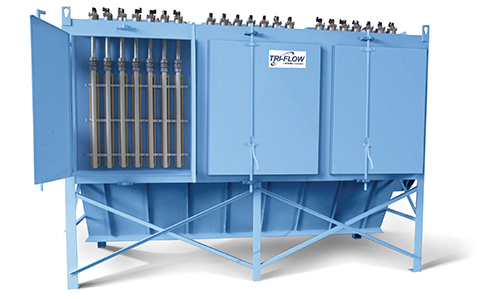

The Tri-Flow Dust Collector Design is preferred throughout industry.
A manufacturer of floor coverings used vent filters on raw material silos. One, fitted to a silo that was filled and emptied constantly, was subject to vibration and fluctuations in pressure and dust loading. It had to be lifted to ground level every three months so bags could be changed and cages repaired.
The company upgraded to the Tri-Flow dust collector design with needle-felt media, completing the installation in less than a day. Twelve weeks later, the filters were inspected. Thanks to the system’s self-cleaning feature. They were clean, and unaffected by the rigorous operating conditions.
Six months later, a second system was converted to the Tri-Flow dust collector design; two others followed. The first filter has now been in service for more than eight years, without maintenance or operational issues. Premature bag failure is no longer a concern, maintenance is simpler, and the company has recovered many times the cost of the conversion.
A vegetable oil producer collected dusts from the processing of soya beans. The dust-laden air is often humid, increasing the tendency of the dust to become sticky. Filter bags were changed often due to blinding or abrasion between the fabric and support cage.
Tri-Flow filters are made from anti-static polyester needlefelt with a microporous coating were installed. Filter life is now 24 months, an eightfold increase in service life. A second filter was subsequently converted with 24 Tri-Flow cartridge filters.
A manufacturer of specialty chemicals uses an attritor dryer to produce graded materials. Product was collected in a sleeve filter, which never delivered above 80% of the dryer design capacity.
The sleeves were replaced by 36 Tri-Flow filters, manufactured from microporous needlefelt media, increasing filter area 80%. The filters provide easy dust release and minimize cross-contamination during product change-over.
Following conversion, the dryer achieved its rated capacity, boosting hourly production by 20%. Previous stoppages for filter cleaning were eliminated, allowing operation to increase from 16 hours to 24 hours.